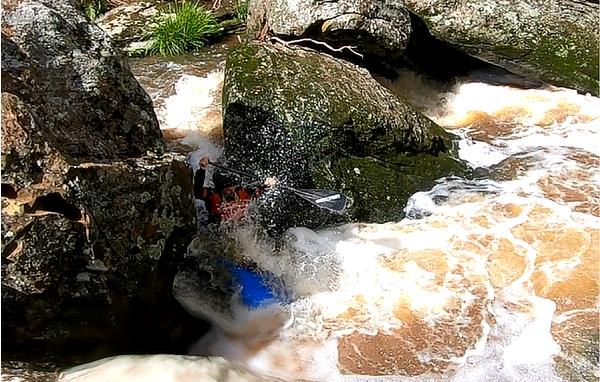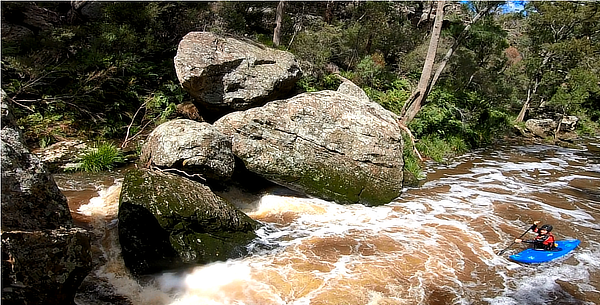Trip Reports | Southern Highlands
Wingecarribee River
Berrima to Macarthurs Crossing
27 March 2021
Trip Leader: STEVEN MOLINO
By STEVEN MOLINO / Images DARREN RASSLACK
We all thought that with all that rain the weekend before there would be something to paddle, so emails started to fly midweek. Everything north of Sydney was still too high and most sections of the Nepean River—including its tributaries—were also all too high.

However, Pheasants Nest to Maldon was coming down and promised to be just right by Saturday—but as Friday night rolled around it looked like it might be dropping too fast. According to the Waterways Guide, the Wingecarribee at 1.2m+ was good and it looked like it was holding. That was our backup plan.
At 6am on Saturday morning, Ben Jones and I made the call. The Nepean had dropped below minimum (0.7m), but the Wingecarribee was still “good” (1.23m). Ten of us had organised to paddle—the others being David Fisher, Luke Barnett, Darren Rassack, Ben Taylor, Aaron Ward, Marshall Wilkinson and two young brothers Ben and Andrew MacCormick, who were joining us for the first time.
For half the group this was the first time they had paddled the Wingecarribee. The other five of us had done this section with River Canoe Club in August 2020 at 1.29m and I alone was paddling this whole section for the third time and the first half for the fourth time.
As always, at the safety briefing I warned that the biggest danger on this run are timber hazards. There are a few trees across the river as well as timber debris wedged in known pinch points. However, because the river narrows in places and there are several blind bends with no obvious eddies, there is always the danger of a new log jam just around the corner. In fact, on our last trip one of our party did not see a jammed log just below the surface downstream of a rapid. This resulted in him swimming and others holding onto the log and rock faces in micro eddies to avoid the same. We were then able to remove the log and haul it to the bank so as not to catch other unwary paddlers.

As last time, we split into two groups of five just to make it easier to eddy out if there was an unexpected hazard—but also because some of the eddies at know portage points aren’t that big. We agreed to wait for the second group at the first portage if they were not in sight and Aaron’s Dad, John, had driven to the mid-point in case we needed an early exit.
As always, this section of river was picturesque, particularly the gorge section with its interesting rock formations and vegetation. Those who had not paddled it before were blown away by its beauty, and the rest of us were again captivated by its charm. However, from very early in the trip it was apparent that the rapids were not as good, with 60mm less water at the Berrima gauge. In fact, when we arrived at the last trip’s log mishap location it was clear the river at that point was more than 600mm lower than last August.
This sort of water level difference meant that we were having to tilt our boats on their sides to slide between rocks, boof over logs which were previously under water, take dodgy lines around fallen trees and rock sieves, and portage a lot more often. The water was not pushy at this flow rate but where it was concentrated it could take you where you didn’t want to go.
On one such occasion I negotiated a line which avoided a sieve, but this proved to be harder for Marshall in his C1 than those in kayaks and he ended up being swept back towards the sieve. He grabbed onto a rock while Aaron—quick as a flash—was out of his boat and scrambling over the rocks to pull him up into the eddy from where he could paddle safely across. At the same time the other group fell behind because one of the young lads got pinned. No real danger, he just had to wait until the others came and pulled him free.
The last rapid on the trip is one of the best but it is a blind chute to the left of a huge boulder into a plunging 1-1.5m drop. Once you start, you are committed as there is nowhere to eddy out. As a precaution I climbed high on the left bank and walked downstream to make sure that no timber had jammed in the drop since last time. It was all clear and I explained the line to everyone. Darren stood on a rock above the boil with a throw rope in case there was a swim.
Aaron, Luke and Marsh shot it fine, so Darren and I climbed down to do the same. Darren sent me down first and it was great fun. As I sat in the eddy below the boil with Marsh, I was about to say to him, “the first time I paddled this rapid John Larsen got temporarily pinned,” when Darren came into view around the rock. He was too far left and hit the drop at an angle instead of straight on and his boat pinned. He pulled his deck and as the boat filled with water he and the boat plunged and popped up in the boil separated from each other.
As we were only 100m from the pull out point we towed Darren and his boat there where he discovered that somewhere in those few seconds the rapid had torn a hole in the deck of his boat, next to the combing. It was the new boat’s maiden voyage. Once we knew he was okay, we left him in the care of John and Ben, and Aaron and I paddled back up and set up safety for the next group. They all came through without mishap.
A walk of moderate gradient and distance saw us back at the cars and we were soon back at Berrima. Following the trip, I got in touch with Jeff Cottrell and requested an update to the Waterways Guide. It now has 1.3m as the minimum level for Good rather than 1.2m. The latter level would be tedious at best and dangerous at worst. I understand that due to a technological hitch the update does not yet appear on the Paddlesafe app.
